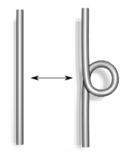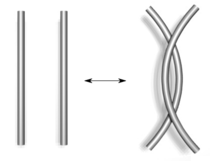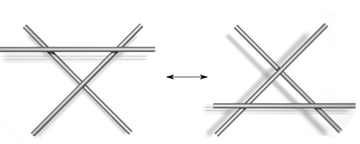Moviments de Reidemeister
 |

|
| 1r moviment | 2n moviment |

| |
| 3r moviment | |
En la teoria de nusos, els moviments de Reidemeister són els tres moviments locals possibles en un diagrama de nus, és a dir els tres canvis més simples possibles que deixen el diagrama mostrant una representació del mateix nus. si dos diagrames representen el mateix nus, pot passar-se d'un a l'altre via els moviments de Reidemeister.
Foren descoberts independentment per Kurt Reidemeister en 1926 i per J. W. Alexander i G. B. Briggs en 1927.
Cadascun dels moviments opera en una petita regió del diagrama. El primer moviment (també anomenat de tipus I) consisteix a girar o crear un bucle. El segon (o de tipus II) consisteix a desplaçar un tros de nus sense creuaments sobre un altre. Finalment el tercer (o de tipus III) consisteix a passar un tros de nus sense creuaments per sobre o per sota d'un creuament. La notació per tipus fa referència a quants fragments de nus o tires estan involucrades. La resta del diagrama no queda modificat per cap d'aquests moviments.
Entre els usos dels moviments de Reidemeister hi trobem tant el fet de poder trobar i identificar nusos equivalents a través dels seus diagrames com el fet de portar diagrames fins a la seva representació més simple. (Vegeu el Teorema de Reidemeister).
També són d'utilitat a l'hora de definir invariants per nusos a través dels diagrames. Demostrant que una propietat d'un diagrama no canvia en aplicar-hi cap dels moviments de Reidemeister queda demostrat que aquesta propietat és invariant per nusos. De fet, alguns invariants per nusos com el Polinomi de Jones poden definir-se d'aquesta manera.
Mentre que el primer i el segon moviments redueixen el nombre de creuaments del diagrama (en un i dos, respectivament), el tercer no ho fa. D'altra banda, el segon i el tercer moviments mantenen invariant l'entortellament, mentre que el primer el fa variar.
Referències
[modifica]- J. W. Alexander; G. B. Briggs, On types of knotted curves. Ann. of Math. (2) 28 (1926/27), no. 1-4, 562–586. (anglès)
- Kurt Reidemeister, Elementare Begründung der Knotentheorie, Abh. Math. Sem. Univ. Hamburg 5 (1926), 24-32 (alemany)
- Bruce Trace, On the Reidemeister moves of a classical knot. Proc. Amer. Math. Soc. 89 (1983), no. 4, 722–724. (anglès)
- Tobias Hagge, Every Reidemeister move is needed for each knot type. Proc. Amer. Math. Soc. 134 (2006), no. 1, 295–301. (anglès)
- Stefano Galatolo, On a problem in effective knot theory. Atti Accad. Naz. Lincei Cl. Sci. Fis. Mat. Natur. Rend. Lincei (9) Mat. Appl. 9 (1998), no. 4, 299–306 (1999). (anglès)
- Lackenby, Marc «A polynomial upper bound on Reidemeister moves» (en anglès). Annals of Mathematics, 183, 2, 2015, p. 491-564. DOI: 10.4007/annals.2015.182.2.3.
- Hass, Joel; Lagarias, Jeffrey C. «The number of Reidemeister moves needed for unknotting» (en anglès). Journal of the American Mathematical Society, 14, 2, 2001, p. 399–428. DOI: 10.1090/S0894-0347-01-00358-7.
- Chuichiro Hayashi, The number of Reidemeister moves for splitting a link. Math. Ann. 332 (2005), no. 2, 239–252. (anglès)
- Adams, Colin C. The Knot Book (en anglès).
Text is available under the CC BY-SA 4.0 license; additional terms may apply.
Images, videos and audio are available under their respective licenses.
